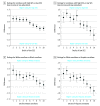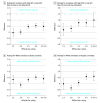Association of Medicare Advantage Star Ratings With Racial, Ethnic, and Socioeconomic Disparities in Quality of Care
- PMID: 35977175
- PMCID: PMC8796982
- DOI: 10.1001/jamahealthforum.2021.0793
Association of Medicare Advantage Star Ratings With Racial, Ethnic, and Socioeconomic Disparities in Quality of Care
Abstract
Importance: Medicare Advantage (MA) plans, which disproportionately enroll racial/ethnic minorities and persons with socioeconomic disadvantage, receive bonus payments on the basis of overall performance on a 5-star rating scale. The association between plans' overall quality and disparities in quality is not well understood.
Objective: To examine the association between MA star ratings and disparities in care for racial/ethnic minorities and enrollees with lower income and educational attainment.
Design setting and participants: This cross-sectional study included 1 578 564 MA enrollees from 454 contracts across the 2015 and 2016 calendar years. Data analyses were conducted between June 2019 and June 2020.
Exposures: Self-reported race and ethnicity and low socioeconomic status (SES) (defined by low income or less than a high school education) vs high SES (neither low income nor low educational attainment).
Main outcomes and measures: Performance on 22 measures of quality and satisfaction determined at the individual enrollee level, aggregated into simulated star ratings (scale, 2-5) stratified by SES and race/ethnicity.
Results: A total of 1 578 564 enrollees were included in this analysis (55.8% female; mean [SD] age, 71.4 [11.3] years; 65.8% White; 12.3% Black; 14.6% Hispanic). Enrollees with low SES had simulated stratified star ratings 0.5 stars lower (95% CI, 0.4-0.6 stars) than individuals with high SES in the same contract. Black and Hispanic enrollees had simulated star ratings that were 0.3 stars (95% CI, 0.2-0.4 stars) and 0.1 stars (95% CI, -0.04 to 0.2 stars) lower than White enrollees within the same contracts. Black enrollees had a 0.4-star lower rating (95% CI, 0.1-0.7 stars) in 4.5- to 5-star contracts and a no statistical difference in 2.0- to 2.5-star-rated contracts (difference, 0.3 stars; 95% CI, -0.02 to 0.7 stars). Hispanic enrollees had a 0.6-star lower simulated rating (95% CI, 0.2-1.0 stars) in 4.5- to 5-star contracts and no statistical difference in 2- to 2.5-star contracts (difference, -0.01 stars; 95% CI, -0.5 to 0.4 stars). There was low correlation between simulated ratings for enrollees of low SES and high SES (difference, 0.2 stars; 95% CI, 0.03-0.4 stars) and between simulated ratings for White and Black enrollees (difference, 0.4 stars; 95% CI, 0.3-0.5 stars) and White and Hispanic enrollees (difference, 0.3 stars; 95% CI, 0.2-0.4 stars). As the proportion of Black and Hispanic enrollees increased in a contract, racial/ethnic disparities in ratings decreased.
Conclusions and relevance: In this cross-sectional study, simulated MA star ratings were only weakly correlated with those for enrollees of low SES in the same contract, and contracts with higher star ratings had larger disparities in quality. Measures of equity in MA plans' quality of care may be needed.
Copyright 2021 Meyers DJ et al. JAMA Health Forum.
Conflict of interest statement
Conflict of Interest Disclosures: Dr Meyers reported receiving grants from the Agency for Healthcare Research and Quality during the conduct of the study and personal fees from NORC outside the submitted work. Dr Rahman reported receiving grants from the National Institute on Aging during the conduct of the study. Prof Mor reported receiving grants from the National Institute on Aging during the conduct of the study, receiving personal fees as the chair of the scientific advisory committee at naviHealth Inc, and is the former chair of the independent quality committee at HCR ManorCare and former director of PointRight Inc, where he holds less than 1% equity. Dr Wilson reported receiving grants from the National Institute of Mental Health during the conduct of the study. Dr Trivedi reported receiving grants from the National Institute on Aging during the conduct of the study and grants from the Agency for Healthcare Research and Quality outside the submitted work.
Figures



Comment in
-
Opportunities to Address Health Disparities in Performance-Based Accountability and Payment Programs.JAMA Health Forum. 2021 Jun 4;2(6):e211143. doi: 10.1001/jamahealthforum.2021.1143. JAMA Health Forum. 2021. PMID: 36218754 No abstract available.
Similar articles
-
Racial and ethnic disparities in access to and enrollment in high-quality Medicare Advantage plans.Health Serv Res. 2023 Apr;58(2):303-313. doi: 10.1111/1475-6773.13977. Epub 2022 Apr 9. Health Serv Res. 2023. PMID: 35342936 Free PMC article.
-
Association of Medicare Advantage Star Ratings With Racial and Ethnic Disparities in Hospitalizations for Ambulatory Care Sensitive Conditions.Med Care. 2022 Dec 1;60(12):872-879. doi: 10.1097/MLR.0000000000001770. Epub 2022 Nov 10. Med Care. 2022. PMID: 36356289 Free PMC article.
-
Contract Termination and Insurance Enrollment Among Medicare Advantage Beneficiaries.JAMA Netw Open. 2024 Aug 1;7(8):e2428267. doi: 10.1001/jamanetworkopen.2024.28267. JAMA Netw Open. 2024. PMID: 39163045 Free PMC article.
-
Racial and Ethnic Disparities in Health Outcomes Among Long-Term Survivors of Childhood Cancer: A Scoping Review.Front Public Health. 2021 Oct 29;9:741334. doi: 10.3389/fpubh.2021.741334. eCollection 2021. Front Public Health. 2021. PMID: 34778176 Free PMC article.
-
Socioeconomic, racial and ethnic differences in patient experience of clinician empathy: Results of a systematic review and meta-analysis.PLoS One. 2021 Mar 3;16(3):e0247259. doi: 10.1371/journal.pone.0247259. eCollection 2021. PLoS One. 2021. PMID: 33657153 Free PMC article.
Cited by
-
Racial And Ethnic Disparities In Patient Experience Of Care Among Nonelderly Medicaid Managed Care Enrollees.Health Aff (Millwood). 2022 Feb;41(2):256-264. doi: 10.1377/hlthaff.2021.01331. Health Aff (Millwood). 2022. PMID: 35130065 Free PMC article.
-
Racial and Ethnic Disparities in Preventive and Chronic Disease Care in Medicare Advantage vs. Traditional Medicare.J Gen Intern Med. 2025 Aug 11. doi: 10.1007/s11606-025-09793-z. Online ahead of print. J Gen Intern Med. 2025. PMID: 40790002
-
Frailty, social deprivation, and mortality among Medicare fee-for-service beneficiaries.J Am Geriatr Soc. 2025 May;73(5):1535-1541. doi: 10.1111/jgs.19318. Epub 2024 Dec 16. J Am Geriatr Soc. 2025. PMID: 39679937
-
Measuring Equity in Readmission as a Distinct Assessment of Hospital Performance.JAMA. 2024 Jan 9;331(2):111-123. doi: 10.1001/jama.2023.24874. JAMA. 2024. PMID: 38193960 Free PMC article.
-
Provider discussion of health goals and psychosocial needs: Comparing older to younger veteran experience.Health Serv Res. 2023 Feb;58 Suppl 1(Suppl 1):9-15. doi: 10.1111/1475-6773.14054. Epub 2022 Sep 21. Health Serv Res. 2023. PMID: 36130799 Free PMC article.
References
Publication types
MeSH terms
Grants and funding
LinkOut - more resources
Full Text Sources
Research Materials

